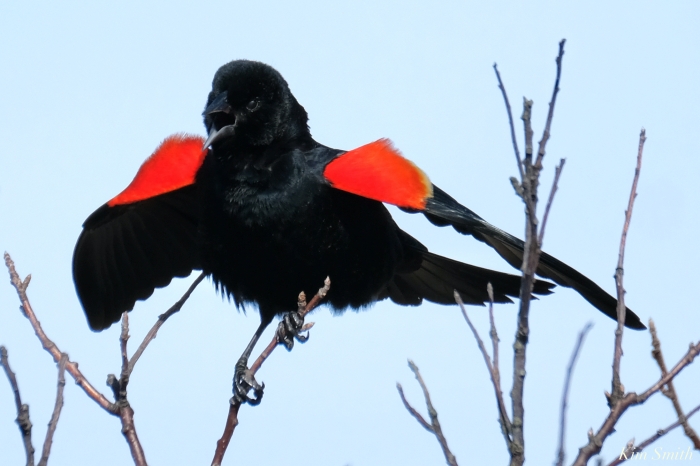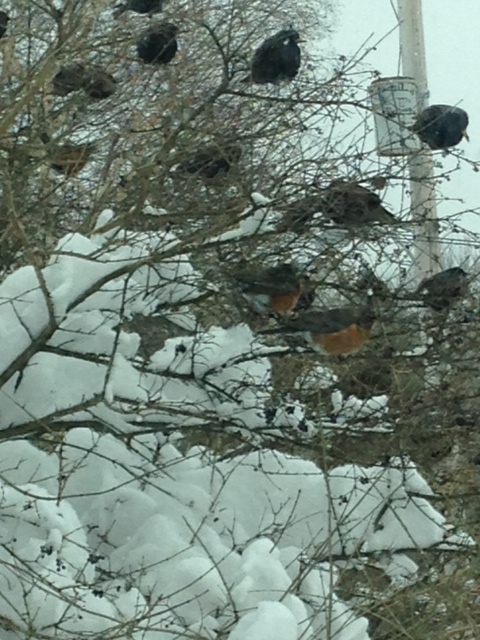 The robins in our community have several different habits for surviving winter. There are year round resident robins that breed throughout Cape Ann during warmer months and also spend the winter here. A second group only breeds in our region, then migrates further south during the winter months. A third group, the robins that we see flocking to our shores beginning round about January 28th, are migrating from parts further north. They are very hungry and are looking for berries, fruit, and small fish.
The robins in our community have several different habits for surviving winter. There are year round resident robins that breed throughout Cape Ann during warmer months and also spend the winter here. A second group only breeds in our region, then migrates further south during the winter months. A third group, the robins that we see flocking to our shores beginning round about January 28th, are migrating from parts further north. They are very hungry and are looking for berries, fruit, and small fish.
In early spring, robins begin to disperse from flocks. The ground thaws and worms, insects, and snails once again become part of the robin’s diet. Spring, too, is when we begin to hear the beautiful liquid notes of the male robin. He is singing to attract a mate. The robin’s song is one of the of most beloved and it is his music with which we associate the coming of spring.
With several edits and updates since I first wrote the following article, I think you’ll find the information helpful in knowing what to feed and to plant for the robins.
 Flock of American Robins Eating Sumac, Halibut Point Rockport
Flock of American Robins Eating Sumac, Halibut Point Rockport
Food for the American Robin
During the winter months Cape Ann often becomes home to large flocks of robins, and we have had the joy of hosting numerous numbers in our garden. I can’t help but notice their arrival. Their shadows descend, crisscrossing the window light, followed by a wild rumpus in the ‘Dragon Lady’ hollies. This pair of hollies is planted on opposing sides of the garden path, alongside my home office. I have learned to stealthily sneak up to a window, as any sudden activity inside startles birds that are investigating our garden, and they quickly disperse. Dining not only on berries of the ‘Dragon Ladies’, but also the ‘Blue Princess’ Meserve holly and winterberry bushes, I find dozens of noisy, hungry robins.
These winter nomads flock to trees and shrubs that hold their fruit through January and February, feasting on red cedar, American holly, Meserve hollies, chokecherries, crabapples, sumac, and juniper. Robins traveling along the shores of Cape Ann also comb the shoreline for mollusks, and go belly-deep for fish fry. Depleting their food supply, they move onto the next location. Gardens rife with fruiting shrubs and trees make an ideal destination for our migrating friends.
Year round resident robins will call your garden home when provided with trays of chopped fruit and raisins, supplemented with meal worms.
What to Plant for Robins
The garden designed to attract nesting pairs of summer resident robins, as well as flocks of winter travelers, would be comprised of trees and shrubs for nest building, plants that bear fruit and berries that are edible during the summer and fall, and plants that bear fruits that persist through the winter months. Suburban gardens and agricultural areas provide the ideal habitat, with open fields and lawns for foraging insects as well as trees and hedgerows in which to build their nests.
The following plants, suggested with robins in mind, will also attract legions of songbirds and Lepidoptera. The list is comprised primarily of indigenous species with a few non-native, but not invasive, plants included.
Trees for nesting ~ American Holly (Ilex opaca), Eastern Red Cedar (Juniperus virginiana), Red Maple (Acer rubrum), Sugar Maple (Acer saccharum), Flowering Dogwood (Cornus florida).
Summer and autumn fruit bearing trees, shrubs and vines for robins ~ Black Cherry (Prunus serotina), Blackberry (Rubus spp.), Flowering Dogwood (Cornus florida), Gray Dogwood (C. racemosa), Red-osier Dogwood (C. sericea), Silky Dogwood (C. amomum), Elderberry (Sambucus canadensis), Apple (Malus pumila), Virginia Rose (Rosa virginiana), Highbush Blueberry (Vaccinium corymbosum), Lowbush Blueberry (Vaccinium angustifolium), Wild Grape (Vitis spp.).
Trees and shrubs with fruits persisting through winter ~ Winterberry (Ilex verticillata), Mountain Ash (Sorbus americana), Crabapple (Malus spp.), Sargent’s Crabapple (Malus sargentii), American Holly (Ilex opaca), Meserve Hollies (Ilex x meserveae), Eastern Red Cedar (Juniperus virginiana), Common Juniper (Juniperus communis), Chokecherry (Prunus virginiana), Smooth Sumac (Rhus glabra), Staghorn Sumac (Rhus typhina).
 American Robin Eating Crabapples
American Robin Eating Crabapples
I Love Sumac
Worms!
The American Robin and Bird Food
Spread The GMG Love By Sharing With These Buttons:


















































































 Vegetable Garden
Vegetable Garden










































































































































